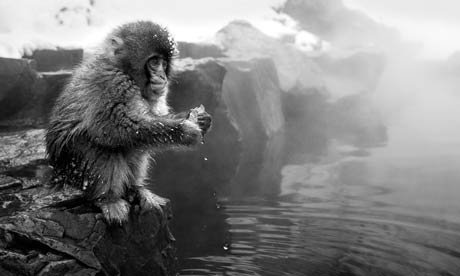
In the latest Wanderlust magazine we feature an incredible photograph of a snow monkey in Jigokudani Valley, Japan. Here's the story behind the shot
Acclaimed photographer David Yarrow’s latest book Encounter is filled with remarkable, rich pictures from around the planet. His captivating image of a snow monkey in the Jigokudani Valley, Japan, featured in the latest issue of Wanderlust. Here David explains how and why he took it…
“Much of my commentary on my work focuses on the danger of the mundane and the low value in simple documentation. The passion that drives my photography is drawn from my core desire to offer not just emotive and contextual imagery, but also fresh imagery. Accessibility is an adversity to photographers who seek to engage with a content-spoilt public, as it creates the very familiarity we now shun.
“The task of capturing ground breaking wildlife imagery in Asia is almost an oxymoron. Japan, South Korea and China are peopled by a huge number of accomplished amateur photographers who know their way around their indigenous camera brands as well as I know my way around football stadiums in Northern Europe. Nikon and Canon still dominate the upper end of the 35mm camera market and it stands to good reason that the continent should punch above its material weight in the number of outstanding amateur and professional photographers it spawns.
“The macaques (snow monkeys) of Japan are the most northerly dwelling monkeys in the world. Whilst they are oblivious to this fact of nature, many wildlife photographers are certainly not. The monkeys are typically unaggressive and indeed they are so familiar with human company that they tend to treat cameramen with total ambivalence. The somewhat inconvenient truth is that these primates are habituated. Of all the wildlife encounters documented in my new book Encounter, the snow monkeys presented the least demanding logistical challenge and consequently the greatest artistic challenge, because their habitat is accessible and their presence and behaviour are largely assured.
“The monkeys are found in the Jigokudani Mountains near Shibu Onsen. This unaffected rural village is characterised by a series of outdoor public bath houses supplied by the rich network of hot springs in the area. The single street community hints at life in rural Japan prior to their industrial revolution. Old traditions hold fast and there is admirable resistance to cater for Western needs – in all my travels, this was the only destination not to offer a bed in the hotel bedroom.
“Shibu Onsen is only an hour from the Olympic city of Nagano, which itself is just two hours by bullet train from Tokyo. Those looking for a fresh experience can leave Europe at midday and by 3pm Japanese time the next day be walking in the serenity of the mountain forests that play host to the snow monkeys.
“But by definition, the snow monkeys should only be photographed in the snow. To do otherwise is to remove the context that defines them. January and February are the best times to visit – the temperatures are well below zero and therefore the snow monkeys are drawn to the warmth of the hot springs. This is an assignment where the ideal weather conditions are the opposite of those that one normally tends to wish for – such as heavy snowfall. On my days in the mountain there was light snowfall, which was still preferable to deep blue skies.
“The mountain climb is not arduous – particularly the path to the east of the park. The good news is that there is no need to carry long telephoto lenses – I wanted to portray an intimacy and trust that can only be conveyed by the sense of proximity that a wide-angle or standard lens affords. This required positioning the camera right on the hot water so as to have the same line of sight as the snow monkeys. There is much to be said for shortening the telephoto power in a camera bag and this picture hopefully testifies to that.”